Effects of Directional Wave Spectra on the Modeling of Ocean Radar Backscatter at Various Azimuth Angles by a Modified Two-Scale Method
Abstract
1. Introduction
2. Data and Methods
2.1. NRCS Data
2.2. Wave Spectra and Spreading Functions
- Cosine spreading function:
- 2.
- Sech spreading function:
- 3.
- Gaussian spreading function:
2.3. Construction of Non-Gaussian Sea Surface
2.4. Modified TSM
3. Results
3.1. Determination of the Modified TSM
3.2. The Influence of Directional Wave Spectra on NRCS Simulation at Different Azimuth Angles
4. Discussion
5. Conclusions
Author Contributions
Funding
Data Availability Statement
Acknowledgments
Conflicts of Interest
References
- Rice, S.O. Reflection of electromagnetic waves from slightly rough surfaces. Commun. Pure Appl. Math. 1951, 4, 351–378. [Google Scholar] [CrossRef]
- Khenchaf, A. Bistatic scattering and depolarization by randomly rough surfaces: Application to the natural rough surfaces in X-band. Waves Random Media 2001, 11, 61–89. [Google Scholar] [CrossRef]
- Bass, F.G.; Fuks, I.M. Wave Scattering from Statistically Rough Surface; Pergamon: Oxford, NY, USA, 1979; pp. 418–442. [Google Scholar]
- Voronovich, A.G. Small-slope approximation for electromagnetic wave scattering at a rough interface of two dielectric half-spaces. Waves Random Media 1994, 4, 337–367. [Google Scholar] [CrossRef]
- Fung, A.K.; Li, Z.; Chen, K.S. Backscattering from a randomly rough dielectric surface. IEEE Trans. Geosci. Remote Sens. 1992, 30, 356–369. [Google Scholar] [CrossRef]
- Hwang, P.A. Comparison of composite Bragg theory and quad-polarization radar backscatter from RADARSAT-2: With applications to wave breaking and high wind retrieval. J. Geophys. Res. Oceans 2010, 115, C11099. [Google Scholar] [CrossRef]
- Rizaev, I.G.; Karakuş, O.; Hogan, S.J.; Achim, A. Modeling and SAR imaging of the sea surface: A review of the state-of-the-art with simulations. ISPRS J. Photogramm. Remote Sens. 2022, 187, 120–140. [Google Scholar] [CrossRef]
- Zhang, M.; Chen, H.; Yin, H.-C. Facet-based investigation on EM scattering from electrically large sea surface with two-scale profiles: Theoretical model. IEEE Trans. Geosci. Remote Sens. 2011, 49, 1967–1975. [Google Scholar] [CrossRef]
- Wan, Y.; Zhang, X.; Dai, Y.; Shi, X. Research on a method for simulating multiview ocean wave synchronization data by networked sar satellites. J. Mar. Sci. Eng. 2019, 7, 180. [Google Scholar] [CrossRef]
- Di Martino, G.; Iodice, A.; Riccio, D. Closed-form anisotropic polarimetric two-scale model for fast evaluation of sea surface backscattering. IEEE Trans. Geosci. Remote Sens. 2019, 57, 6182–6194. [Google Scholar] [CrossRef]
- Li, D.; Zhao, Z.; Qi, C.; Huang, Y.; Zhao, Y.; Nie, Z. An improved two-scale model for electromagnetic backscattering from sea surface. IEEE Geosci. Remote Sens. Lett. 2020, 17, 953–957. [Google Scholar] [CrossRef]
- Wang, T.; Tong, C. An improved facet-based tsm for electromagnetic scattering from ocean surface. IEEE Geosci. Remote Sens. Lett. 2018, 15, 644–648. [Google Scholar] [CrossRef]
- Awada, A.; Ayari, M.Y.; Khenchaf, A. Bistatic scattering from an anisotropic sea surface: Numerical comparison between the first-order SSA and the TSM models. Wave Random Complex 2006, 16, 383–394. [Google Scholar] [CrossRef]
- Vaitilingom, L.; Khenchaf, A. Radar Cross Section of Sea and Ground Clutter Estimated by Two Scale Model and Small Slope Approximation in HF-VHF Bands. Electromagn Waves 2011, 29, 311–338. [Google Scholar] [CrossRef]
- Sajjad, N.; Khenchaf, A.; Coatanhay, A. Depolarization of electromagnetic waves from bare soil surfaces. In Scientific Computing in Electrical Engineering SCEE 2010; Springer: Berlin/Heidelberg, Germany, 2012; Volume 16, pp. 107–115. [Google Scholar]
- Ayari, M.Y.; Khenchaf, A.; Coatanhay, A. Simulations of the bistatic scattering using two-scale model and the unified sea spectrum. J. Appl. Remote Sens. 2007, 1, 013532. [Google Scholar] [CrossRef]
- Arnold-Bos, A.; Khenchaf, A.; Martin, A. Bistatic radar imaging of the marine environment—Part I: Theoretical background. IEEE Trans. Geosci. Remote Sens. 2007, 45, 3372–3383. [Google Scholar] [CrossRef]
- Longuet-Higgins, M.S. On the skewness of sea-surface slopes. J. Phys. Ocean 1982, 12, 1283–1291. [Google Scholar] [CrossRef]
- Chen, K.S.; Fung, A.K.; Amar, F. An empirical bispectrum model for sea surface scattering. IEEE Trans. Geosci. Remote Sens. 1993, 31, 830–835. [Google Scholar] [CrossRef]
- Xie, D.; Chen, K.S.; Yang, X. Effect of bispectrum on radar backscattering from non-Gaussian sea surface. IEEE J. Sel. Topics Appl. Earth Observ. Remote Sens. 2019, 12, 4367–4378. [Google Scholar] [CrossRef]
- Bourlier, C. Upwind-downwind asymmetry of the sea backscattering normalized radar cross section versus the skewness function. IEEE Trans. Geosci. Remote Sens. 2018, 56, 17–24. [Google Scholar] [CrossRef]
- Bourlier, C. Azimuthal harmonic coefficients of the microwave backscattering from a non-Gaussian ocean surface with the first-order SSA model. IEEE Trans. Geosci. Remote Sens. 2004, 42, 2600–2611. [Google Scholar] [CrossRef]
- Wang, Y.H.; Guo, L.X.; Wu, Z.S. Modified two-scale model for electromagnetic scattering from the non-Gaussian oceanic surface. Chin. Phys. Lett. 2005, 22, 2808–2811. [Google Scholar]
- Hwang, P.A.; Plant, W.J. An analysis of the effects of swell and surface roughness spectra on microwave backscatter from the ocean. J. Geophys. Res. Ocean. 2010, 115. [Google Scholar] [CrossRef]
- Zheng, H.; Khenchaf, A.; Wang, Y.; Ghanmi, H.; Zhang, Y.; Zhao, C. Sea surface monostatic and bistatic EM scattering using SSA-1 and UA VSAR data: Numerical evaluation and comparison using different sea spectra. Remote Sens. 2018, 10, 1084. [Google Scholar] [CrossRef]
- Xie, D.; Chen, K.S.; Yang, X. Effects of wind wave spectra on radar backscatter from sea surface at different microwave bands: A numerical study. IEEE Trans. Geosci. Remote Sens. 2019, 57, 6325–6334. [Google Scholar] [CrossRef]
- Miao, Y.; Dong, X.; Bourassa, M.A.; Zhu, D. Effects of ocean wave directional spectra on Doppler retrievals of ocean surface current. IEEE Trans. Geosci. Remote Sens. 2021, 60, 1–12. [Google Scholar] [CrossRef]
- La, T.V.; Khenchaf, A.; Comblet, F. Assessment of wind speed estimation from C-band Sentinel-1 images using empirical and electromagnetic models. IEEE Trans. Geosci. Remote Sens. 2018, 56, 4075–4087. [Google Scholar] [CrossRef]
- La, T.V.; Khenchaf, A.; Comblet, F. Exploitation of C-band Sentinel-1 images for high-resolution wind field retrieval in coastal zones (Iroise Coast, France). IEEE J. Sel. Topics Appl. Earth Observ. Remote Sens. 2017, 10, 5458–5471. [Google Scholar] [CrossRef]
- Zhang, B.; Perrie, W.; He, Y. Wind speed retrieval from RADARSAT-2 quad-polarization images using a new polarization ratio model. J. Geophys. Res. Oceans 2011, 116, 1–13. [Google Scholar] [CrossRef]
- Verspeek, J.; Stoffelen, A.; Portabella, M. Validation and calibration of ASCAT using CMOD5.n. IEEE Trans. Geosci. Remote Sens. 2009, 48, 386–395. [Google Scholar] [CrossRef]
- Wu, Y.; Fan, C.; Yan, Q.; Zhang, J. Modified Two-Scale Model for Better Prediction of the Up/Down Wind Asymmetry in Radar Backscattering from the Ocean Surface. IGARSS 2022, 2022, 1991–1994. [Google Scholar]
- Wilson, J.J.; Anderson, C.; Baker, M.A.; Bonekamp, H.; Saldaña, J.F.; Dyer, R.G.; Lerch, J.A.; Kayal, G.; Gelsthorpe, R.V.; Brown, M.A.; et al. Radiometric calibration of the advanced wind scatterometer radar ASCAT carried onboard the METOP-A satellite. IEEE Trans. Geosci. Remote Sens. 2010, 48, 3236–3255. [Google Scholar] [CrossRef]
- Liu, W.T.; Tang, W. Equivalent Neutral Wind; JPL Publ. Lab: Pasadena, CA, USA, 1996; pp. 17–96. [Google Scholar]
- Plant William, J. Effects of wind variability on scatterometry at low wind speeds. J. Geophys. Res. Oceans 2000, 105, 16899–16910. [Google Scholar] [CrossRef]
- Apel, J.R. An improved model of the ocean surface wave vector spectrum and its effects on radar backscatter. J. Geophys. Res. Oceans 1994, 99, 16269–16291. [Google Scholar] [CrossRef]
- Elfouhaily, T.; Chapron, B.; Katsaros, K.; Vandemark, D. A unified directional spectrum for long and short wind-driven waves. J. Geophys. Res. Oceans 1997, 102, 15781–15796. [Google Scholar] [CrossRef]
- Hwang, P.A.; Fan, Y. Low-frequency mean square slopes and dominant wave spectral properties: Toward tropical cyclone remote sensing. IEEE Trans. Geosci. Remote Sens. 2018, 56, 7359–7368. [Google Scholar] [CrossRef]
- Donelan, M.A.; Hamilton, J.; Hui, W.H. Directional spectra of wind-generated waves. Philos. Trans. R. Soc. London Ser. A Math. Phys. Sci. 1985, 315, 509–562. [Google Scholar]
- Banner, M.L. Equilibrium spectra of wind waves. J. Phys. Oceanogr. 1990, 20, 966–984. [Google Scholar] [CrossRef]
- Plant, W.J. A two-scale model of short wind-generated waves and scatterometry. J. Geophys. Res. Oceans 1986, 91, 10735–10749. [Google Scholar] [CrossRef]
- Cox, C.; Munk, W. Measurement of the roughness of the sea surface from photographs of the Sun’s Glitter. J. Opt. Soc. Amer. 1954, 44, 838–850. [Google Scholar] [CrossRef]
- Hwang, P.A.; Fois, F. Surface roughness and breaking wave properties retrieved from polarimetric microwave radar backscattering. J. Geophys. Res. Oceans 2015, 120, 3640–3657. [Google Scholar] [CrossRef]
- Yurovskaya, M.V.; Dulov, V.A.; Chapron, B. Directional short wind wave spectra derived from the sea surface photography. J. Geophys. Res. Oceans 2013, 118, 4380–4394. [Google Scholar] [CrossRef]
- Tayfun, M.A. On narrow-band representation of ocean waves: 1. Theory. J. Geophys. Res. Oceans 1986, 91, 7743–7752. [Google Scholar] [CrossRef]
- Nouguier, F.; Guérin, C.A.; Chapron, B. “Choppy wave” model for nonlinear gravity waves. J. Geophys. Res. Oceans 2009, 114, 1–14. [Google Scholar] [CrossRef]
- Wu, Y.; Fan, C.; Yan, Q.; Meng, J.; Song, T.; Zhang, J. Effects of Wind Wave Spectra, Non-Gaussianity, and Swell on the Prediction of Ocean Microwave Backscatter with Facet Two-Scale Model. Remote Sens. 2023, 15, 1469. [Google Scholar] [CrossRef]
- Du, Y.L.; Yang, X.F.; Chen, K.S. An Improved Spectrum Model for Sea Surface Radar Backscattering at L-Band. Remote Sens. 2017, 9, 776. [Google Scholar] [CrossRef]
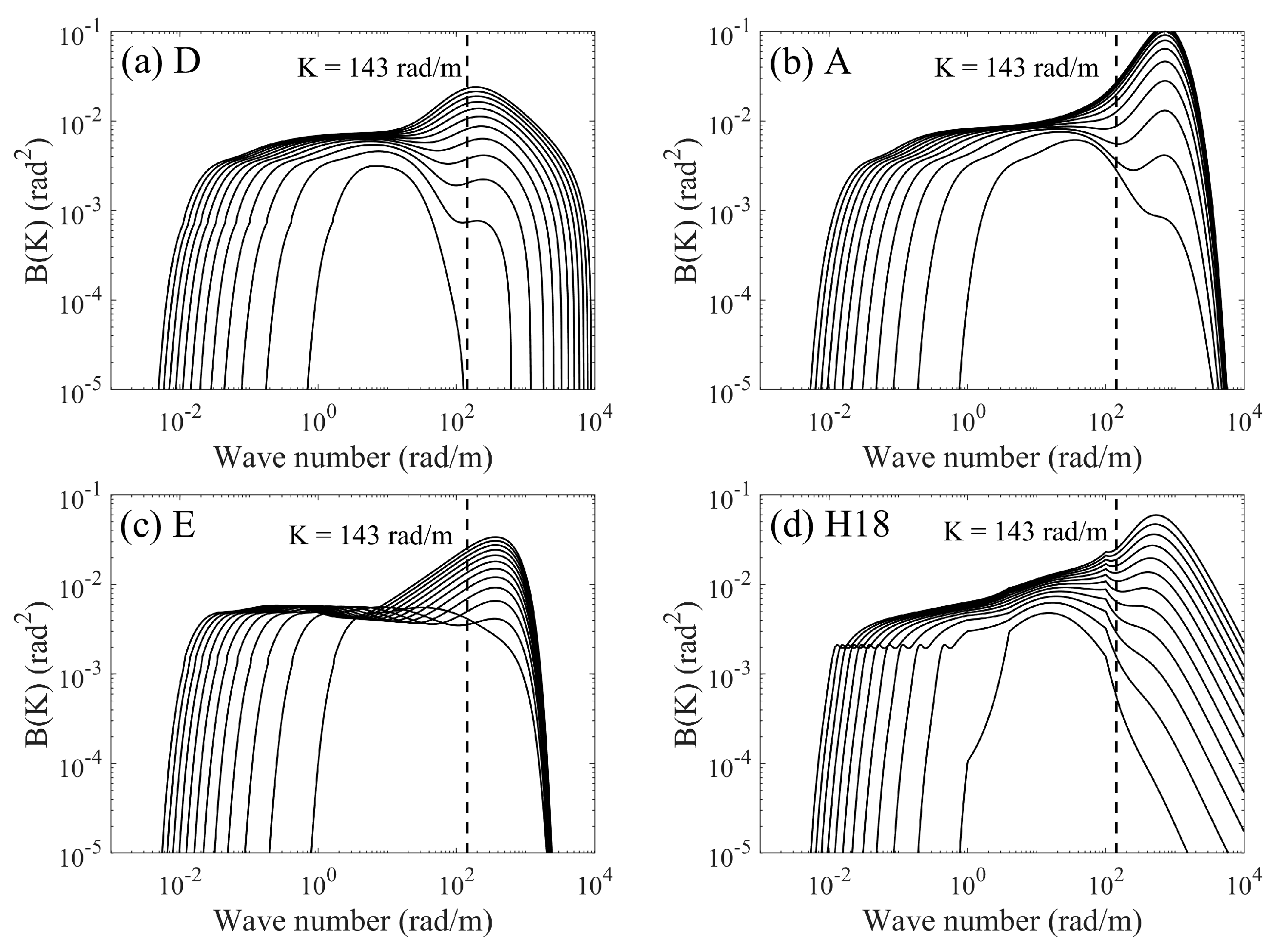



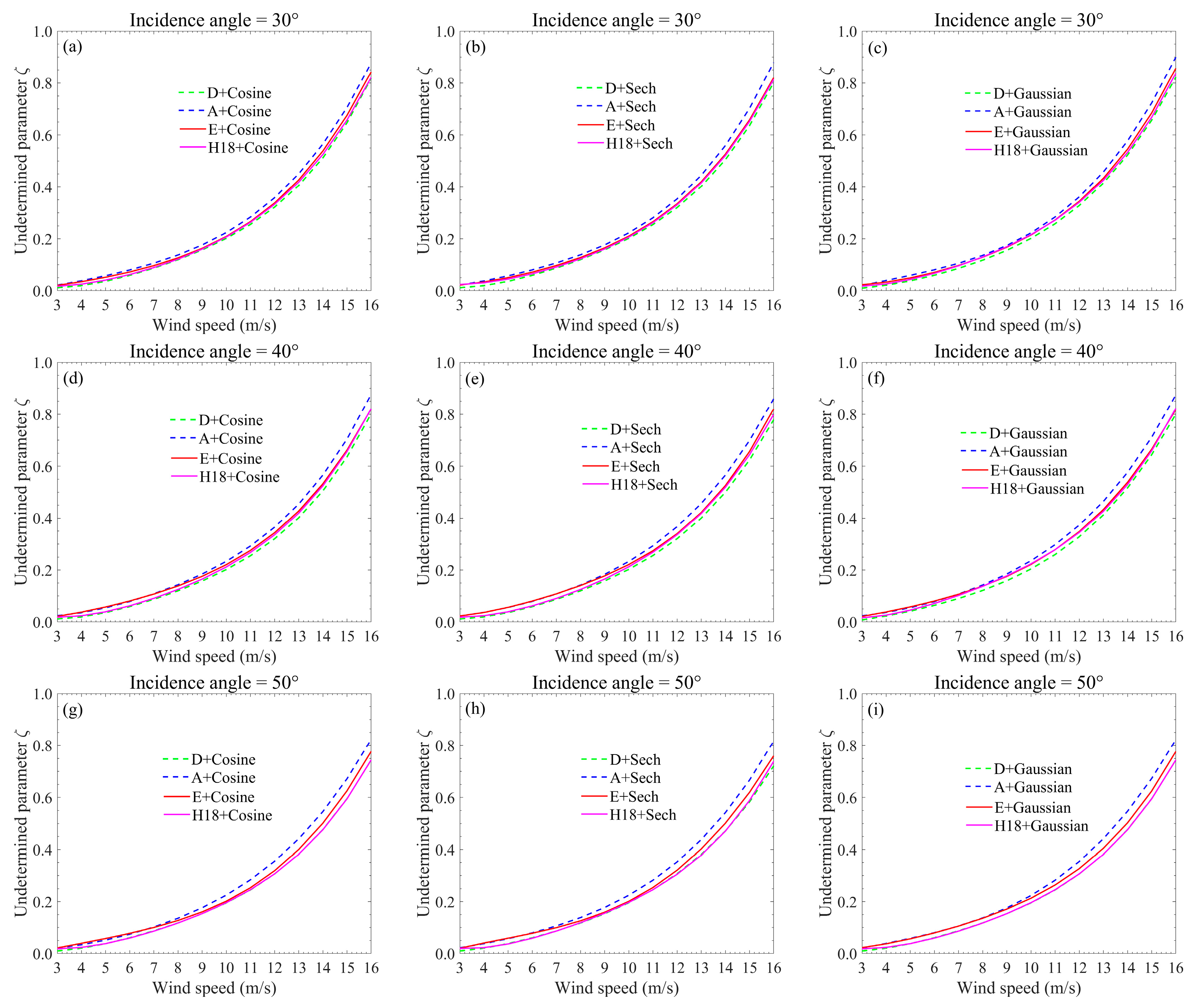
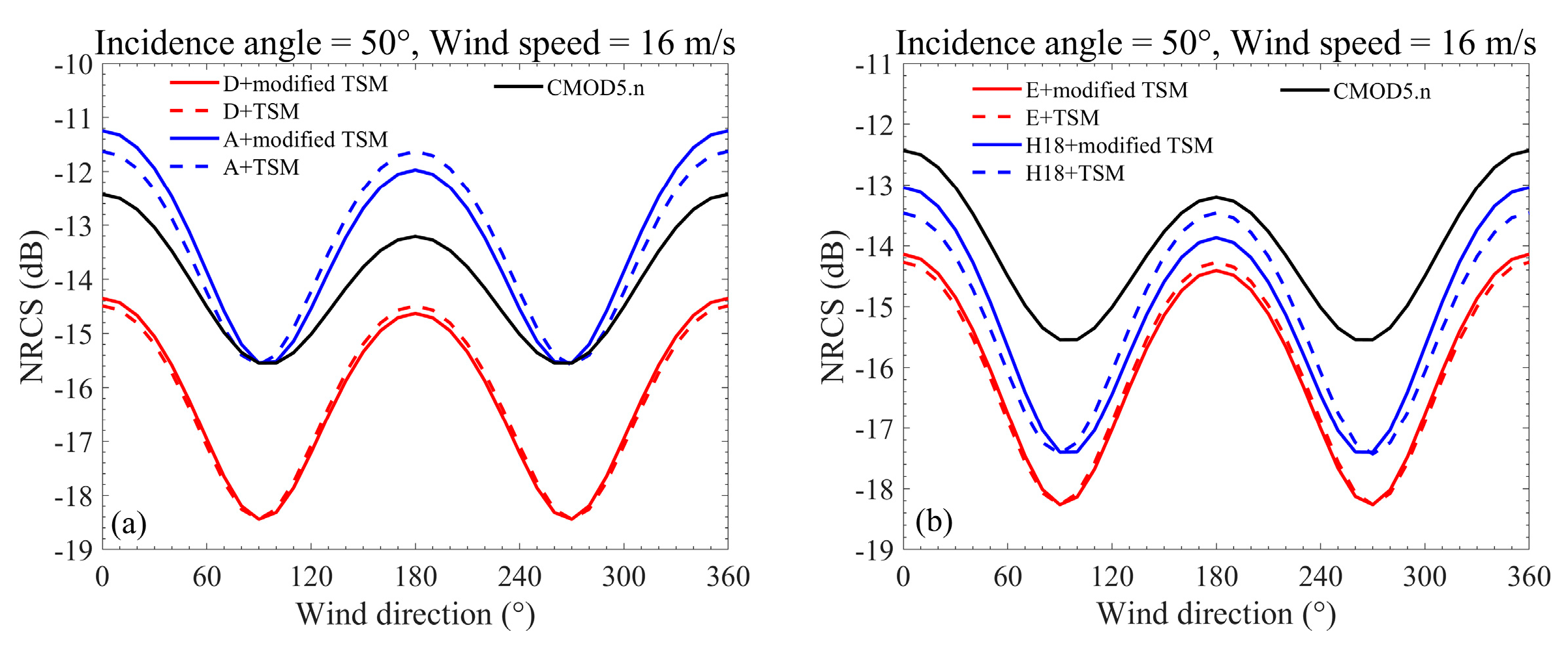


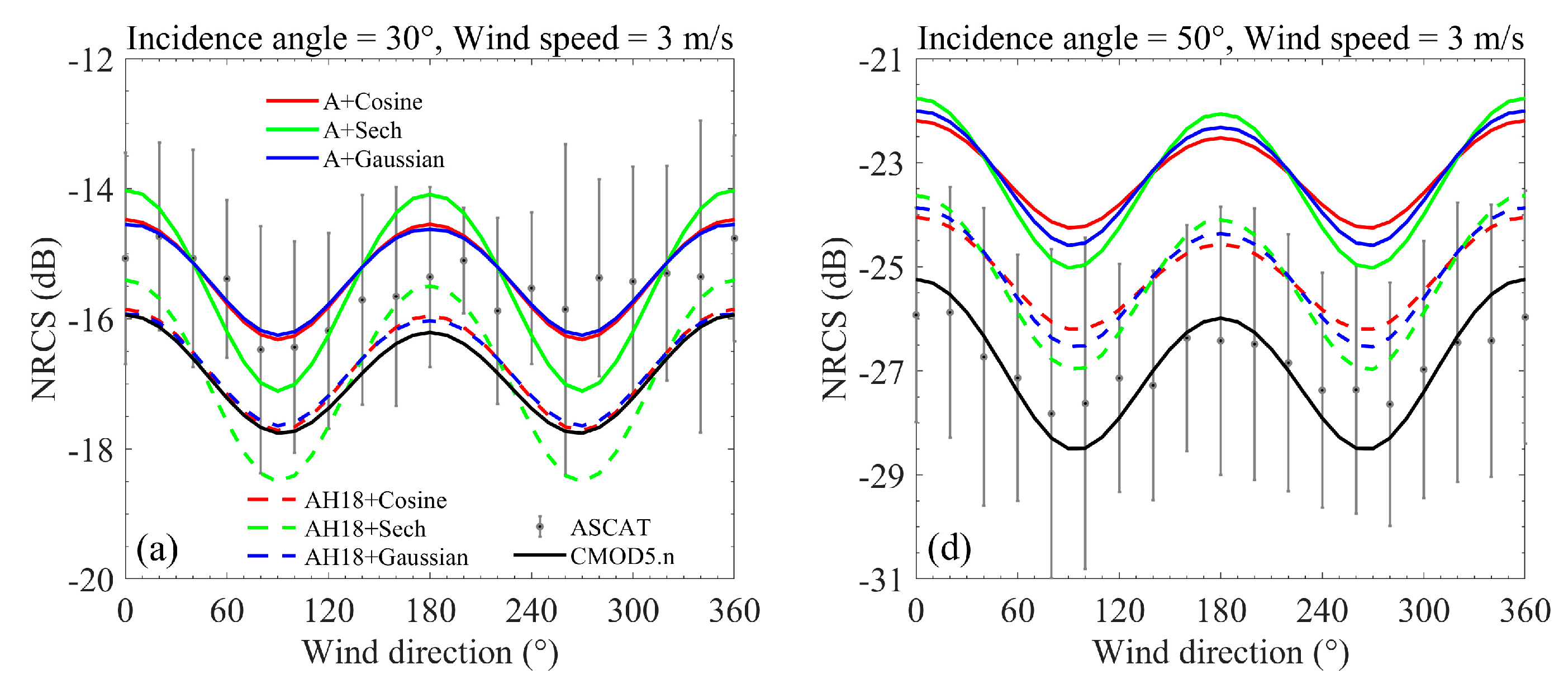
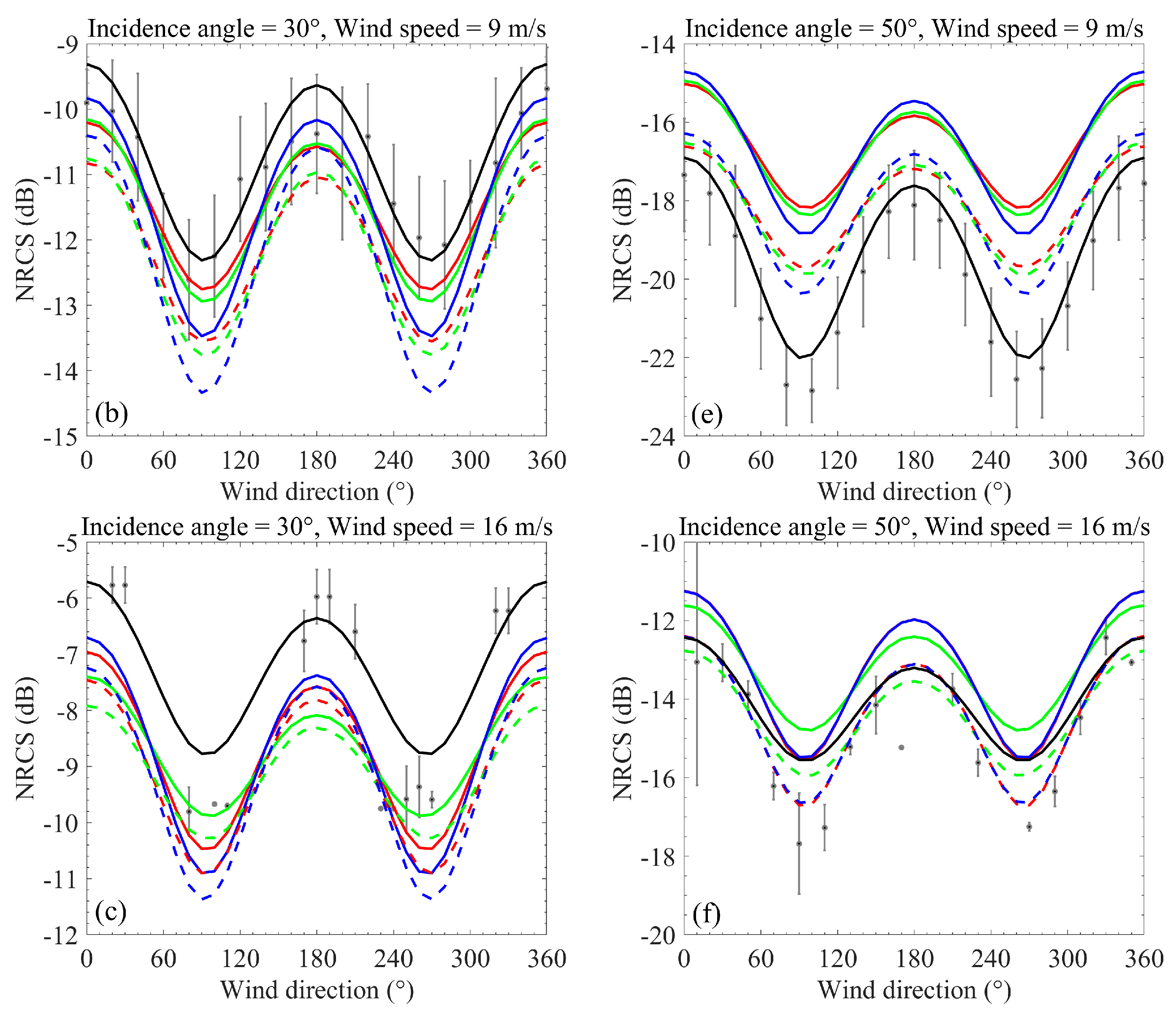
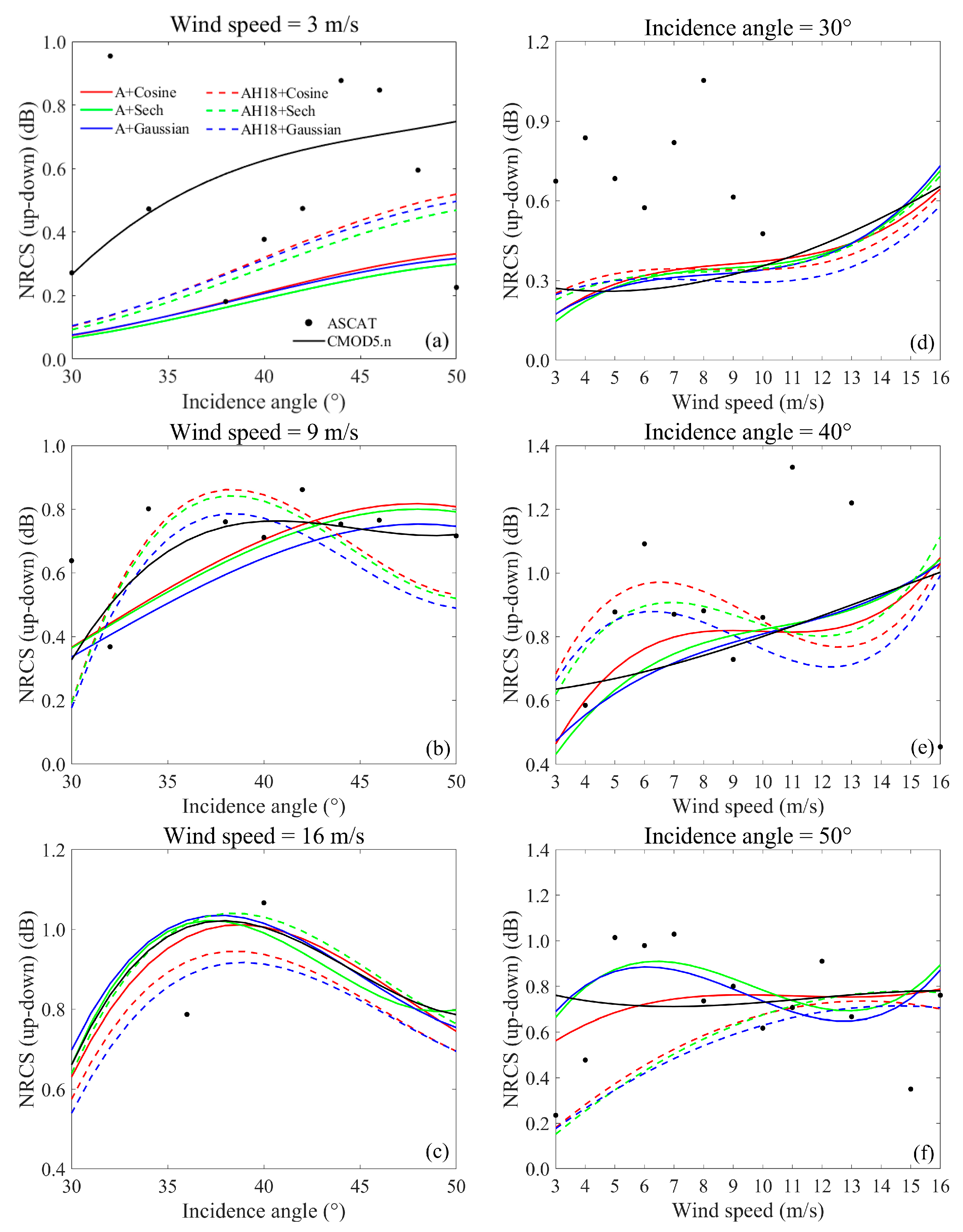


| Wave Spectrum | 3 m/s | 9 m/s | 16 m/s | |||||||||
|---|---|---|---|---|---|---|---|---|---|---|---|---|
| 30°–40° | 40°–50° | 30°–40° | 40°–50° | 30°–40° | 40°–50° | |||||||
| Bias | std | Bias | std | Bias | std | Bias | std | Bias | std | Bias | std | |
| D | −8.2 | 0.8 | −6.6 | 0.6 | −3.1 | 0.9 | −1.6 | 1.0 | −2.8 | 0.6 | −2.2 | 0.6 |
| A | 2.4 | 0.6 | 3.3 | 0.5 | 0.4 | 1.0 | 2.0 | 1.0 | −0.9 | 0.6 | 0.2 | 0.6 |
| E | 2.4 | 0.8 | 4.1 | 0.7 | −0.9 | 1.0 | 0.7 | 1.0 | −2.3 | 0.5 | −1.5 | 0.5 |
| H18 | −1.9 | 0.3 | −2.0 | 0.5 | −1.8 | 0.5 | −1.4 | 0.8 | −2.1 | 0.5 | −2.0 | 0.6 |
| AH18 | 0.7 | 0.4 | 1.4 | 0.4 | −0.6 | 0.8 | 0.7 | 0.9 | −1.4 | 0.5 | −0.6 | 0.5 |
| AEH18 | 1.4 | 0.6 | 2.5 | 0.6 | −0.7 | 0.8 | 0.7 | 0.9 | −1.7 | 0.5 | −1.0 | 0.5 |
| Wave Spectrum | 3 m/s | 9 m/s | 16 m/s | |||||||||
|---|---|---|---|---|---|---|---|---|---|---|---|---|
| 30°–40° | 40°–50° | 30°–40° | 40°–50° | 30°–40° | 40°–50° | |||||||
| Bias | std | Bias | std | Bias | std | Bias | std | Bias | std | Bias | std | |
| D | −8.9 | 1.0 | −6.7 | 0.7 | −2.5 | 0.9 | −1.0 | 1.0 | −2.4 | 0.7 | −1.8 | 0.8 |
| A | 1.7 | 0.8 | 3.2 | 0.5 | 1.0 | 0.9 | 2.6 | 1.0 | −0.5 | 0.7 | 0.6 | 0.9 |
| E | 1.8 | 1.1 | 4.0 | 0.7 | −0.3 | 1.0 | 1.3 | 1.0 | −1.9 | 0.7 | −1.1 | 0.9 |
| H18 | −2.6 | 0.4 | −2.1 | 0.4 | −1.2 | 0.5 | −0.8 | 0.8 | −1.8 | 0.7 | −1.6 | 0.8 |
| AH18 | 0.1 | 0.7 | 1.3 | 0.4 | 0.1 | 0.7 | 1.3 | 1.0 | −1.0 | 0.8 | −0.2 | 0.7 |
| AEH18 | 0.7 | 0.8 | 2.4 | 0.6 | −0.1 | 0.8 | 1.3 | 1.0 | −1.2 | 0.7 | −0.6 | 0.9 |
| Wave Spectrum | Wind Speed (m/s) | ||||||||||||||
|---|---|---|---|---|---|---|---|---|---|---|---|---|---|---|---|
| 16 | 17 | 18 | 19 | 20 | 21 | 22 | 23 | 24 | 25 | 26 | 27 | 28 | 29 | 30 | |
| A | 0.80 | 1.00 | 1.40 | 1.80 | 2.40 | 3.40 | 5.00 | 8.00 | 29.00 | 25.00 | 9.00 | 5.00 | 4.00 | 3.00 | 2.00 |
| AEH18 | 0.80 | 1.00 | 1.40 | 1.80 | 2.40 | 3.40 | 5.00 | 8.00 | 29.00 | 25.00 | 9.00 | 5.00 | 4.00 | 3.00 | 2.00 |
| Wave Spectrum | Wind Speed (m/s) | ||||||||||||||
|---|---|---|---|---|---|---|---|---|---|---|---|---|---|---|---|
| 16 | 17 | 18 | 19 | 20 | 21 | 22 | 23 | 24 | 25 | 26 | 27 | 28 | 29 | 30 | |
| A | 0.84 | 1.00 | 1.40 | 1.80 | 2.20 | 3.20 | 4.80 | 8.00 | 27.00 | 24.00 | 9.00 | 5.00 | 4.00 | 3.00 | 2.50 |
| AEH18 | 0.84 | 1.00 | 1.40 | 1.80 | 2.20 | 3.20 | 4.80 | 8.00 | 27.00 | 24.00 | 9.00 | 5.00 | 4.00 | 3.00 | 2.50 |
| Wave Spectrum | Wind Speed (m/s) | ||||||||||||||
|---|---|---|---|---|---|---|---|---|---|---|---|---|---|---|---|
| 16 | 17 | 18 | 19 | 20 | 21 | 22 | 23 | 24 | 25 | 26 | 27 | 28 | 29 | 30 | |
| A | 0.80 | 1.00 | 1.20 | 1.60 | 2.00 | 2.80 | 4.20 | 7.00 | 25.00 | 22.00 | 8.00 | 5.00 | 3.00 | 3.00 | 2.00 |
| AEH18 | 0.80 | 1.00 | 1.20 | 1.60 | 2.00 | 2.80 | 4.20 | 7.00 | 25.00 | 22.00 | 8.00 | 5.00 | 3.00 | 3.00 | 2.00 |
Disclaimer/Publisher’s Note: The statements, opinions and data contained in all publications are solely those of the individual author(s) and contributor(s) and not of MDPI and/or the editor(s). MDPI and/or the editor(s) disclaim responsibility for any injury to people or property resulting from any ideas, methods, instructions or products referred to in the content. |
© 2023 by the authors. Licensee MDPI, Basel, Switzerland. This article is an open access article distributed under the terms and conditions of the Creative Commons Attribution (CC BY) license (https://creativecommons.org/licenses/by/4.0/).
Share and Cite
Yan, Q.; Wu, Y.; Fan, C.; Meng, J.; Song, T.; Zhang, J. Effects of Directional Wave Spectra on the Modeling of Ocean Radar Backscatter at Various Azimuth Angles by a Modified Two-Scale Method. Remote Sens. 2023, 15, 2191. https://doi.org/10.3390/rs15082191
Yan Q, Wu Y, Fan C, Meng J, Song T, Zhang J. Effects of Directional Wave Spectra on the Modeling of Ocean Radar Backscatter at Various Azimuth Angles by a Modified Two-Scale Method. Remote Sensing. 2023; 15(8):2191. https://doi.org/10.3390/rs15082191
Chicago/Turabian StyleYan, Qiushuang, Yuqi Wu, Chenqing Fan, Junmin Meng, Tianran Song, and Jie Zhang. 2023. "Effects of Directional Wave Spectra on the Modeling of Ocean Radar Backscatter at Various Azimuth Angles by a Modified Two-Scale Method" Remote Sensing 15, no. 8: 2191. https://doi.org/10.3390/rs15082191
APA StyleYan, Q., Wu, Y., Fan, C., Meng, J., Song, T., & Zhang, J. (2023). Effects of Directional Wave Spectra on the Modeling of Ocean Radar Backscatter at Various Azimuth Angles by a Modified Two-Scale Method. Remote Sensing, 15(8), 2191. https://doi.org/10.3390/rs15082191





